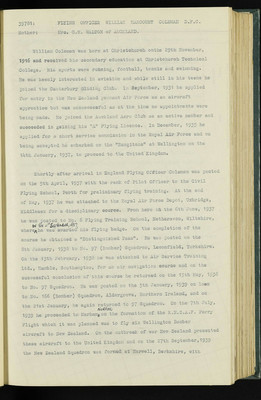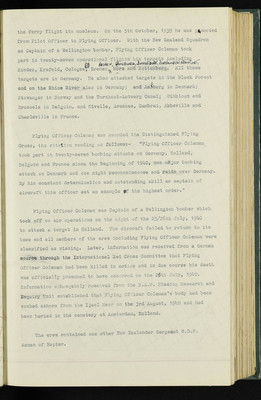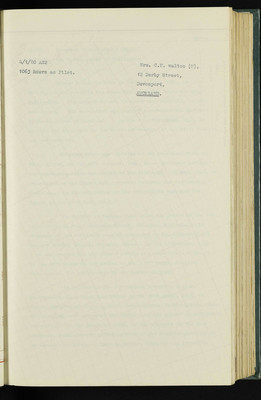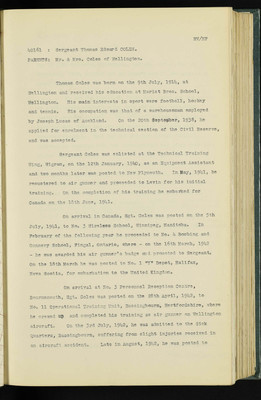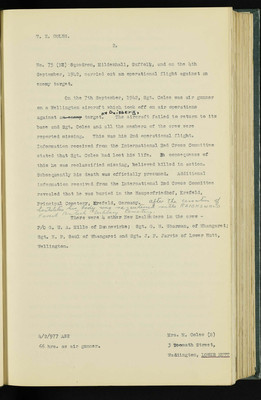Pages
26
39781: FLYING OFFICER WILLIAM HARCOURT COLEMAN D.F.C. Mother: Mrs. C. M. WALTON of AUCKLAND.
William Coleman was born at Christchurch onthe 29th November, 1916 and received his secondary education at Christchurch Technical College. His sports were running, football, tennis and swimming. He was keenly interested in aviation and while still in his teens he joined the Canterbury Gliding Club. In September, 1931 he applied for entry in the New Zealand permanent Air Force as an aircraft apprentice but was unsucessful as at the time no appointments were being made. He joined the Auckland Aero Club as an active member a succeeded in gaining his "A" Flying Licence. In December, 1935 he applied for a short service commission in the Royal Air Force and on being accepted he embarked on the "Rangitane" at Wellington on the 14th January, 1937, to proceed to the United Kingdom.
Shortly after arrival in England Flying Officer Coleman was posted on the 5th April, 1937 with the rank of Pilot Officer to the Civil Flying School, Perth for preliminary flying training. At the end of May, 1937 he was attached to the Royal Airforce Depot, Uxbridge, Middlesex, for a disciplinary course. From here on the 6th June, 1937 he was posted to No. 6 Flying School, Netheravon, Wiltshire, where on the 4th September, 1937, he was awarded his flying badge. On the completion of the course he obtained a "Distinguished Pass". He was posted on the 8th January, 1938 to No. 97 (Bomber) Squadron, Leconfield, Yorkshire. On the 13th February, 1938 he was attached to Air Service Training Ltd., Hamble, Southampton, for an air navigation course and on the successful conclusion of this course he returned on the 15th May, 1938 to No. 97 Squadron. He was posted on the 5th January, 1939 on loan to No. 166 (Bomber) Squadron, Aldergrove, Northern Ireland, and on the 21st January, he again returned to No. 97 Squadron. On the 7th July, 1939 he proceeded to Narham, Norfolk, on the formation of the R.N.Z.A.F. Ferry Flight it was planned was to fly six Wellington Bomber aircraft to New Zealand. On the outbreak of war New Zealand presented these aircraft to the United Kingdom and on the 27th September, 1939 the New Zealand Squadron was formed at Harwell, Berkshire, with
27
the ferry flight its nucleus. On the 5th October, 1939 he was promoted from Pilot Officer to Flying Officer. With the New Zealand Squadron as Captain of a Wellington Bomber, Flying Officer Coleman took part in twenty-seven operation flights his targets including Minden, Krefold, Cologne(3), Bremen, Aache, Duisburg, Dusseldorf, Dortmund(2), Frankfurt, Mors and Rottenberg. All these targets are in Germany. He also attacked targets in the Black Forest and on the Rhine River, also in Germany; and Aacborg in Denmark; Stavanger in Norway and the Turnhout-Antwerp Canal; Gimbloux and Brussels in Belgium, and Nivelle, Avesnes, Cambrai, Abbeville and Charleville in France.
Flying Officer Coleman was awarded the Distinguished Flying Cross, the citation reading as follows:- "Flying Officer Coleman took part in twenty-seven bombing attacks on Germany, Holland, Belgium and France since the beginning of 1940, one major bombing attack on Denmark and on night reconnaissance and raids over Germany. By his constant determination and outstanding skill as captain of aircraft this officer set an example of the highest order."
Flying Officer Coleman was Captain of a Wellington bomber which took off on air operations on the night of the 25/26th July, 1940 to attack a target in Holland. The aircraft failed to return to its base and all members of the crew including Flying Officer Coleman were classified as missing. Later, information was received from a German source through the International Red Cross Committee that Flying Officer Coleman had been killed in action and in due course his death was officially presumed to have occurred on the 26th July, 1940. Information subsequently received from the R.A.F. Missing Research and Enquiry Unit established that Flying Officer Coleman's body had been washed ashore from the Ijsel Meer on the 3rd August, 1940 and had been buried in the cemetery at Amsterdam, Holland.
The crew contained one other New Zealander Sergeant W.D.F. Annan of Napier.
28
4/1/80 AS2 1063 hours as Pilot
Mrs. C.M. Walton (M) 12 Derby Street Devonport, AUCKLAND.
29
4016: Sergeant Thomas Edward COLES. PARENTS: Mr. & Mrs. Coles of Wellington
Thomas Coles was born on the 9th July, 1914, at Wellington and received his education at Marist Bros. School, Wellington. His main interests in sport were football, hockey, and tennis. His occupation was that of a warehouseman employed by Joseph Lucas of Auckland. On the 20th September, 1938, he applied for enrolment in the technical section of the Civil Reserve, and was accepted. Sergeant Coles was enlisted at the Technical Training Wing, Wigram, on the 12th January, 1940, as an Equipment Assistant and two months later was posted to New Plymouth. In May, 1941, he remustered to air gunner and proceeded to Levin for his initial training. On the completion of his training he embarked for Canada on the 18th June, 1941. On arrival in Canada, Sgt. Coles was posted on the 5th July, 1941, to No. 3 Wireless School, Winnipeg, Manitoba. In February of the following year he proceeded to No. 4 Bombing and Gunnery School, Fingal, Ontario, where - on the 16th March, 1942 - he was awarded his air gunners badge and promoted to Sergeant. On the 18th March he was posted to No. 1. "Y" Depot, Halifax, Nova Scotia, for embarkation to the United Kingdom. On arrival at No. 3 Personnel Reception Center, Bournemouth, Sgt. Coles was posted on the 28th April, 1942, to No. 11 Operation Training Unit, Bassingbourne, Hertfordshire, where he crewed up and completed his training as air gunner on Wellington aircraft. On the 3rd July 1942, he was admitted to the Sick Quarters, Bassingbourne, suffering from slight injuries received in an aircraft accident. Late in August, 1942, he was posted to
30
T. E. COLES. 2.
No. 75 (NZ) Squadron, Mildenhall, Suffolk, and on the 4th September, 1942, carried out an operational flight against an enemy target. On the 7th September, 1942, Sgt. Coles was air gunner on a Wellington aircraft which took off on air operations against target at Duisberg. The aircraft failed to return to its base and Sgt. Coles and all the members of the crew were reported missing. This was his 2nd operational flight. Information received from the International Red Cross Committee stated that Sgt. Coles had lost his life. In consequence of this he was reclassified missing, believed killed in action. Subsequently his death was officially presumed. Additional information received from the International Red Cross Committee revealed that he was buried in the Hauperfriedhof, Krefeld, Principal Cemetery, Erefield, Germany. [handwritten] After the cessation of hostilities his body was re-interred in the REICHSWALD Forest British Military Cemetery. [/handwritten] There were 4 other New Zealanders in the crew - P/O G.W.A. Mills of Dannevirke; Sgt. G.W. Sharman, of Whangarei; Sgt. N.P. Saul of Whangarei and Sgt. J. F. Jarvis of Lower Hutt, Wellington.
4/2/977 AS2 66 hrs as air gunner
Mrs M. Coles (M) 3 Toomath Street, Waddington, LOWER HUTT
